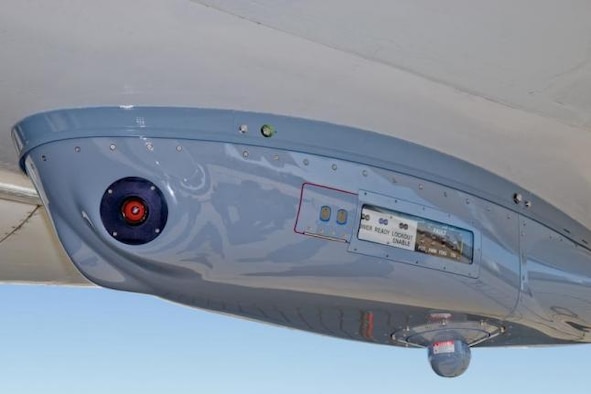By Jaimi L. Upthegrove, Air Force Reserve Command Public Affairs / Published July 03, 2015

DOWNLOAD HI-RES / PHOTO DETAILS
A Large Aircraft Infrared Countermeasures system pod is mounted onto a large aircraft. The Air National Guard and Air Force Reserve are scheduled to receive three new system pods that will allow tankers to safely get closer to the fight for refueling. (Courtesy photo)
ROBINS AIR FORCE BASE, Ga. (AFNS) — The Air National Guard and Air Force Reserve are scheduled to receive three new system pods that will allow tankers to safely get closer to the fight for refueling.
Under a $31.7 million order, Northrop Grumman will provide two full Large Aircraft Infrared Countermeasures system pods and one shell, designed for the KC-135 Stratotanker, and support flight testing and training activities in fiscal year 2016.

The Guard and Reserve will share the three pods. The pods have 360-degree coverage; they can detect and track man-portable, air-defense missile launch systems and use a laser to jam missile’s guidance system, causing them to miss the targeted aircraft.“The pods can be taken off one aircraft and installed on another with relative ease, so they will be centrally located and installed based on need downrange,” said Senior Master Sgt. James Rose, the KC-135 weapons system manager for Air Force Reserve Command Headquarters here. “This is going to make the fuel receivers more efficient because we have the capability to safely stay closer to the fight instead of them needing to come all the way out when they get low on fuel.”
The system includes a laser pointer/tracker and four infrared missile-warning sensors. The system is contained in a pod that mounts to the underside of an aircraft body and can be removed from one aircraft and installed on another similar to a child’s car seat.
“This open architecture configuration, with its increased capability and reliability, provides the next level of aircraft protection,” said Carl Smith, the vice president of infrared countermeasure programs, Land and Self Protection Systems Division, Northrop Grumman. “Block 30 builds on the company’s more than 15 years of experience in battle-proven, laser-based infrared countermeasures. The third-generation role-fit pod configuration offers reliable, flexible protection that is ideally suited to numerous military and commercial aircraft.”
Rose said the system pods are scheduled to be tested at Tinker Air Force Base, Oklahoma, and then will be centrally located for joint use wherever they are most needed.
“This system benefits aircrews by allowing them to fly into hotspots without worrying about the missiles the guys on the ground want to fire at them,” Rose said.